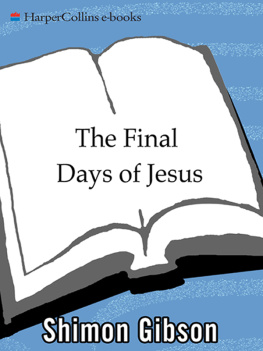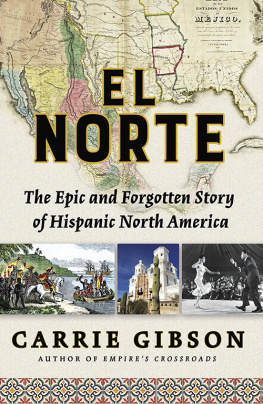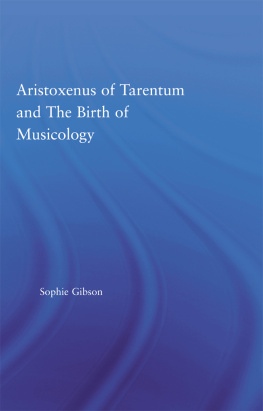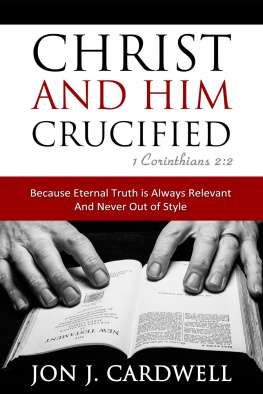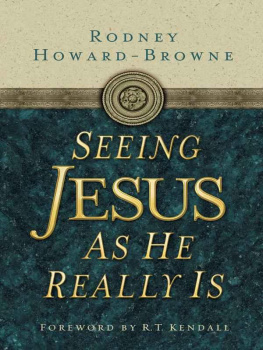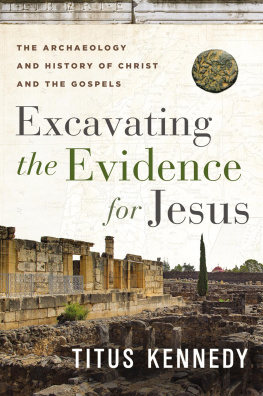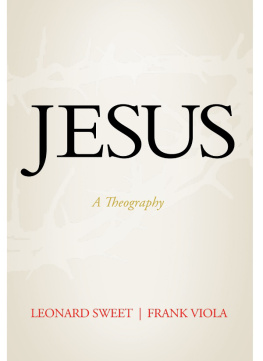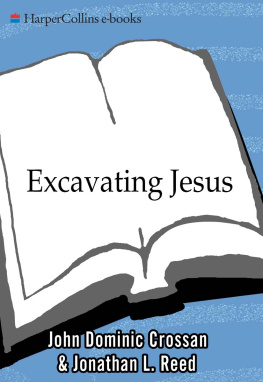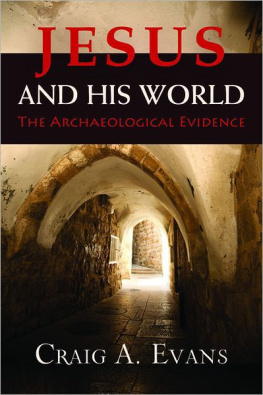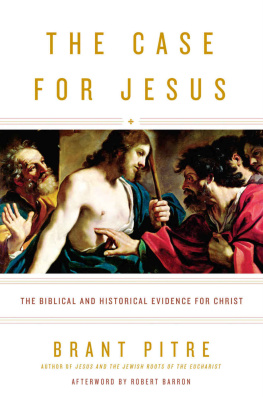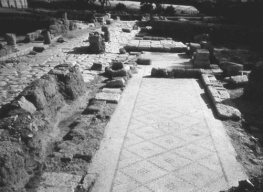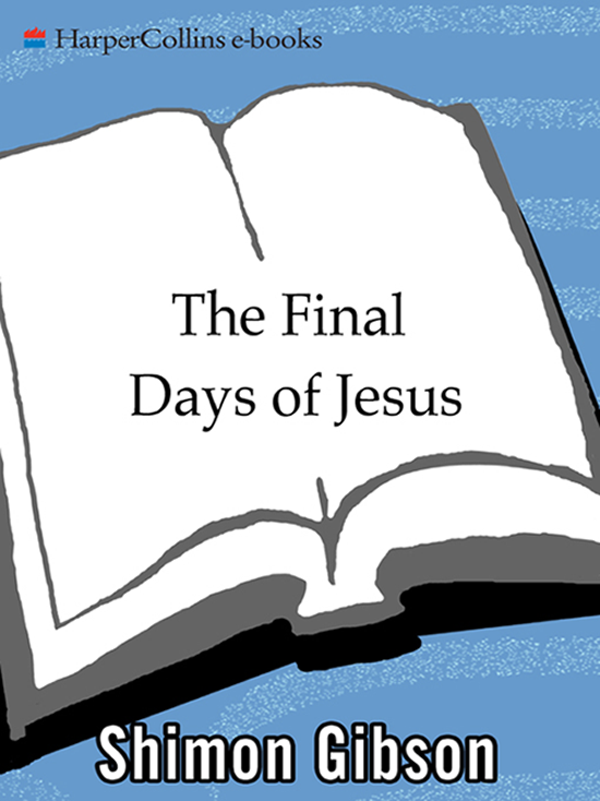W ho was Jesus, and what can archaeology tell us about him? I am sure many people want to know this. The theologians and historians have had their gomany thousands of books attest to thisbut what can archaeology contribute in the quest to find out more about the historical Jesus? Does archaeology just provide illustrative material for the context/background of the Gospel accounts, a kind of garnish for the focused historical perspective? Or can it provide us with unique, valuable information that can change substantially the way we perceive Jesus and his final days in Jerusalem as set forth in the Gospel accounts?
I believe archaeology is an undervalued and untapped source of rich data on the historical Jesus, and I hope to show this in the pages of this book. Archaeology should be allowed its own voice alongside the information and ideas that emerge from the historical exegesis of the Gospels. They both have their problems: Archaeological remains may be too fragmentary or interpreted incorrectly; textual sources may be too garbled from transmission or replete with errors by copyists. Archaeology, therefore, should be used appropriatelyneither to support and prop up the account of Jesus in Jerusalem nor to deny and tear down the historicity of that account. It should be an independent means of testing the validity of the Gospel accounts, to compare and contrast them with historical studies. Archaeology can provide structured explanations and interpretations of specific events, such as the trial of Jesus, and these subsequently need to be tested and woven into the historical perspective.
Archaeological sites are multi-layered, as are the textual accountsboth require dissection and critical examination to elucidate the many truths of the past. This is admittedly a difficult and complex task. Understanding the topography of Jerusalem and the layout of the city is essential. Also, having a good grasp of Jewish material remains of the first century is vital. Artifacts with inscriptions can be very helpful: A fragment of a block of stone from Caesarea bearing the name and exact title of Pontius Pilate is a major find and a boon for scholarship. A tomb with the name of Caiaphas on one of its ossuaries is yet another major archaeological discovery highlighting the Gospel story. Other inscriptions, such as the James ossuary, are of dubious value because they come from the collections of antiquities dealers and not directly from scientific excavations, but this should not dampen the usefulness of archaeology in elucidating the Gospel narrative.
The need to know more about the places in which Jesus spent his last critical days began a long time ago. This is clearly reflected in the constant flow of Christian pilgrims to the Holy Land and particularly to Jerusalem, which began in the fourth century and continues to the present day. Most worshippers desire to see with their own eyes the main sites associated with the Gospel stories: the traditional site of the room of the Last Supper on Mount Zion; the gnarled olive trees of Gethsemane on the Mount of Olives; the pavement of Gabbatha at the place where Jesus was tried by Pontius Pilate; the Via Dolorosa along which Jesus carried his cross; the Rock of Calvary where Jesus was brought for crucifixion; and the Edicule in the Church of the Holy Sepulchre covering the vestiges of the Tomb of Jesus.
Inevitably, the same questions are asked by visiting pilgrims and travelers: How reliable are these traditional spots? How certain can we be that the authentic tomb of Jesus is indeed located at the Church of the Holy Sepulchre? In the nineteenth century, alternative locations for some of the secondary holy sites in Jerusalem were given by local guides and by resident clergy, resulting in a lot of confusion and some suspicion amongst those visiting the city. The discomfort pilgrims and travelers felt in having to make educated guesses is apparent in some of their travel accounts.
In the early twentieth century, travelers were confronted with an alternative tomb of Jesus at the Garden Tomb on the north side of the city, which caused further confusion. Today, Christian pilgrims are much more demanding and discerning and require scientific verification for explanations given by tourist guides in respect to the traditional Gospel sites. However, this does not mean they always get what they want.
From where have people derived information about the final days of Jesus? Visual reconstructions occasionally appear on the stage and the big screen. I am thinking particularly of Andrew Lloyd Webber and Tim Rices excellent musical Jesus Christ Superstar. For cinematic renderings, there is the wonderful black-and-white movie by Pier Paolo Pasolini and the other newer movie, The Last Temptation of Christ, which managed to create quite a furor when it was released. More recently, I came out of Mel Gibsons movie about Jesuss final days, The Passion of Christ, feeling like Id been drenched in gratuitous Hollywood blood. The movie was not being shown in Jerusalem because local distributors deemed the subject uninteresting for the general Israeli public; instead I watched a bootleg version, subtitled both in Arabic and English, in the rather quaint sitting room of the British School of Archaeology in East Jerusalem.
Thousands of scholarly studies have been written about Jesus the prophet and healer; his early mission around the Sea of Galilee; his ideas, sayings, and eschatological messages; and his experiences with John the Baptist at the Jordan River. Scholars agree that none of the Gospels is an eyewitness account of the events it describes, since each was written almost forty to sixty years after the death of Jesus. And so, at best, the Synoptic Gospels (Mark, Matthew, and Luke) may be regarded as conveying oral tradition that was to some extent embroidered and embellished as part of the literary process. The Fourth Gospel ( John) undoubtedly made use of a lot of historical data that were not available to the other three Gospel writers. The best way to get to some degree of truth about what actually happened, it has been argued, is through the careful historical and literary analysis of the Gospels and their possible sources. However, archaeology has quite a lot to offer, more so than has previously been realized.
In this book I concentrate on Jesuss final days during the Passover week in Jerusalem in 30 CE . Beginning with the road Jesus took to Jerusalem and his sojourn in Bethany, I examine Jesuss activities within the city, particularly at the Jewish Temple and in the adjacent Pools of Bethesda and Siloam. The scene of the trial is investigated and fresh archaeological discoveries are revealed for the first time. Knowing what the place of the trial looked like allows one to visualize the proceedings in a way not previously possible. Questions relating to the exact place of Jesuss crucifixion and burial are also dealt with and new archaeological discoveries are presented. A burial shroud from the first century, uncovered in Jerusalem, is compared to the famous Turin Shroud. Many new ideas and explanations have resulted from my personal quest to follow in the footsteps of the historical Jesus in Jerusalem. The reader may be astonished by some of these results.

